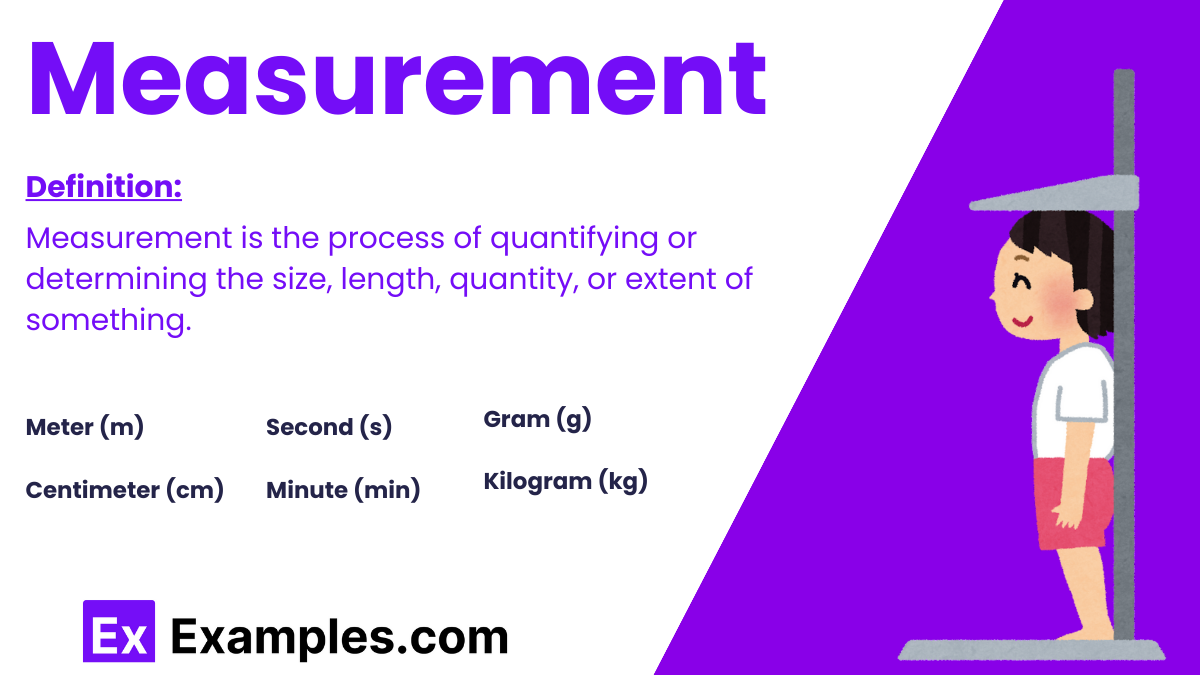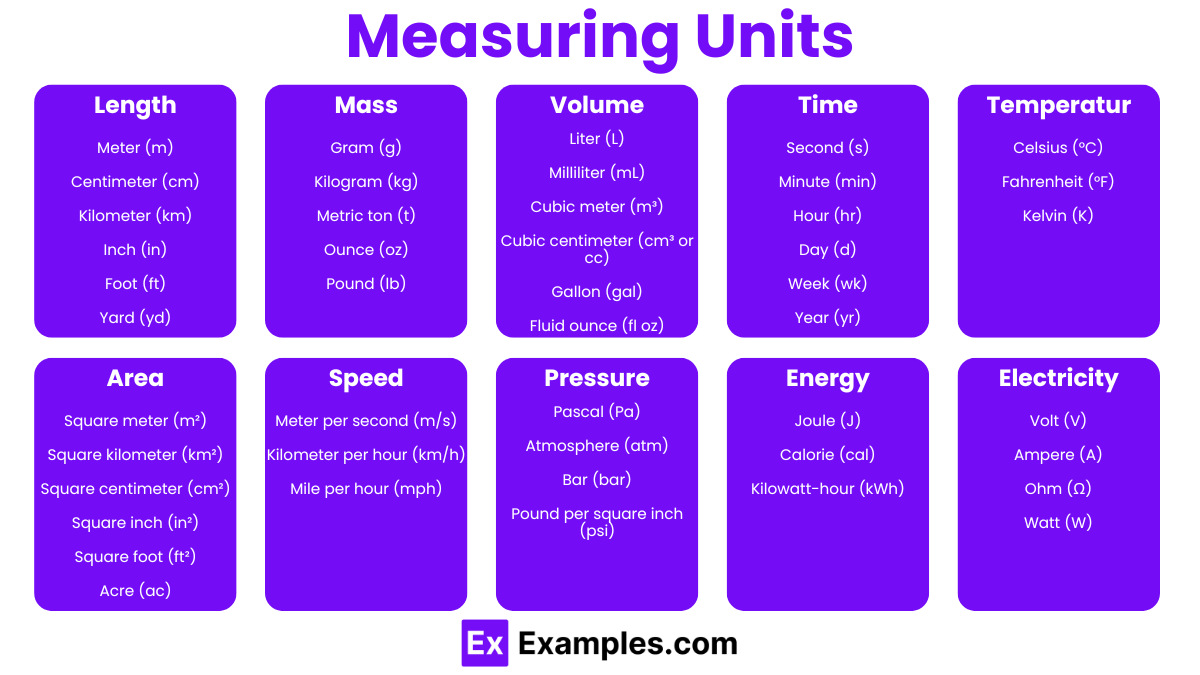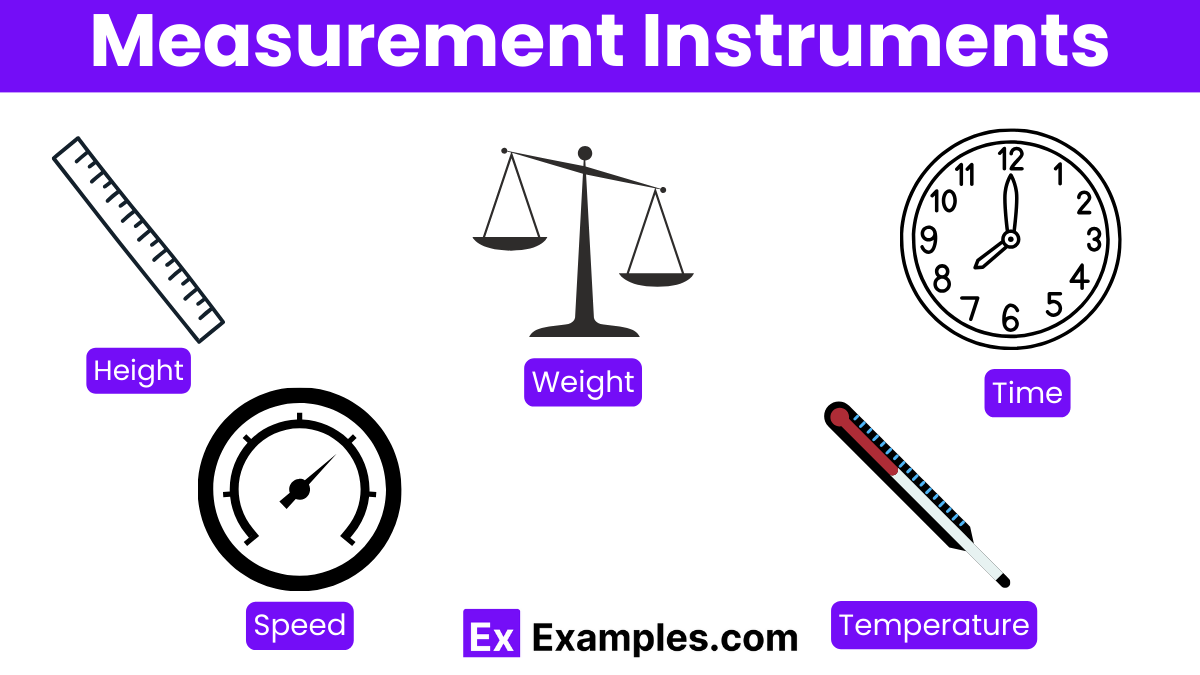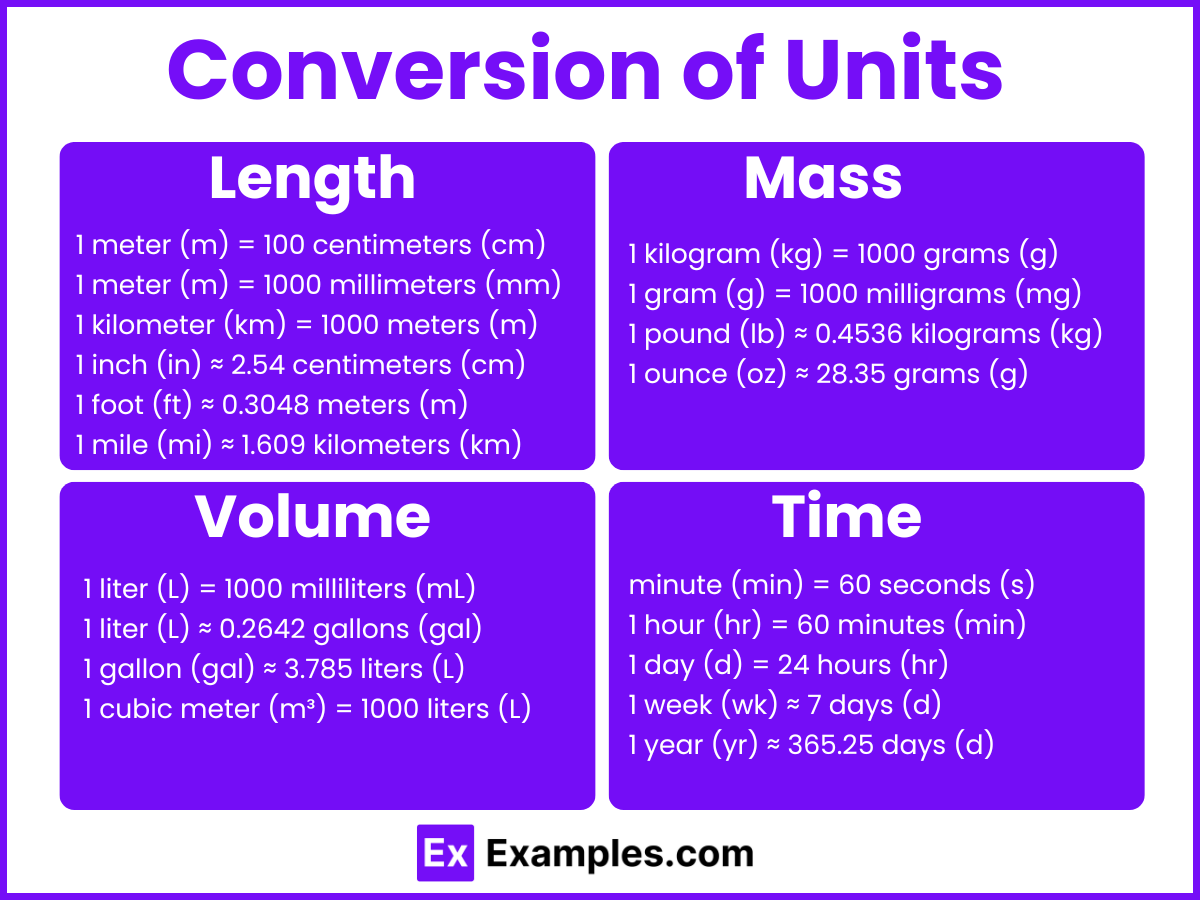What is the unit of measurement for electric current?
Volt
Ampere
Ohm
Watt


Measurement is the process of quantifying or determining the size, length, quantity, or extent of something. It involves using standardized units to express the magnitude of a physical quantity, attribute, or phenomenon. In various fields such as science, engineering, economics, and everyday life, measurement plays a crucial role in providing accurate data for analysis, comparison, and decision-making. Whether it’s measuring length, time, temperature, or any other parameter, the concept of measurement is fundamental to understanding the world around us and making sense of the information we encounter.
There are some basic types of measurement variables that we deal with in several areas of mathematics. They are:

Measurement units are standardized quantities used to express the magnitude of a physical quantity. They provide a common language for communication and comparison across different contexts. Here are some common measurement units across various categories:
Length:
Mass:
Volume:
Time:
Temperature:
Area:
Speed:
Pressure:
Energy:
Electricity:
Measurement instruments are tools or devices used to quantify and assess various physical quantities accurately. They play a crucial role across diverse fields, including science, engineering, manufacturing, healthcare, and research. Here are some common types of measurement instruments:


Section A: Multiple Choice Questions
Section B: Short Answer Questions
Section C: Long Answer Questions
The symbol for inches is “in” or sometimes a double prime (“) placed after the numerical value. It represents the imperial unit of length commonly used in the United States and a few other countries.
The 10 basic units of measurement include length (meter), mass (kilogram), time (second), electric current (ampere), temperature (kelvin), amount of substance (mole), luminous intensity (candela), angle (radian), and solid angle (steradian).
The five major types of measurements are length, mass, time, temperature, and electric current. These fundamental measurements serve as the basis for quantifying various physical quantities and are essential in science, engineering, and everyday life.
The four basic measurements are length, mass, time, and temperature. These measurements are fundamental and widely used across different fields for quantifying physical quantities, conducting experiments, and making comparisons.
The terms of measurement list includes units of measurement used to quantify various physical quantities. It encompasses length (meter), mass (kilogram), time (second), temperature (kelvin), electric current (ampere), and other units for measuring specific attributes or phenomena.

Measurement is the process of quantifying or determining the size, length, quantity, or extent of something. It involves using standardized units to express the magnitude of a physical quantity, attribute, or phenomenon. In various fields such as science, engineering, economics, and everyday life, measurement plays a crucial role in providing accurate data for analysis, comparison, and decision-making. Whether it’s measuring length, time, temperature, or any other parameter, the concept of measurement is fundamental to understanding the world around us and making sense of the information we encounter.
There are some basic types of measurement variables that we deal with in several areas of mathematics. They are:
Time
Length
Weight
Volume
Temperature
Area
Speed
Pressure
Energy
Electricity

Measurement units are standardized quantities used to express the magnitude of a physical quantity. They provide a common language for communication and comparison across different contexts. Here are some common measurement units across various categories:
Length:
Mass:
Gram (g)
Kilogram (kg)
Metric ton (t)
Ounce (oz)
Pound (lb)
Volume:
Liter (L)
Milliliter (mL)
Cubic meter (m³)
Cubic centimeter (cm³ or cc)
Gallon (gal)
Fluid ounce (fl oz)
Time:
Second (s)
Minute (min)
Hour (hr)
Day (d)
Week (wk)
Year (yr)
Temperature:
Celsius (°C)
Fahrenheit (°F)
Kelvin (K)
Area:
Square meter (m²)
Square kilometer (km²)
Square centimeter (cm²)
Square inch (in²)
Square foot (ft²)
Acre (ac)
Speed:
Meter per second (m/s)
Kilometer per hour (km/h)
Mile per hour (mph)
Pressure:
Pascal (Pa)
Atmosphere (atm)
Bar (bar)
Pound per square inch (psi)
Energy:
Joule (J)
Calorie (cal)
Kilowatt-hour (kWh)
Electricity:
Volt (V)
Ampere (A)
Ohm (Ω)
Watt (W)
Measurement instruments are tools or devices used to quantify and assess various physical quantities accurately. They play a crucial role across diverse fields, including science, engineering, manufacturing, healthcare, and research. Here are some common types of measurement instruments:

Rulers and Tape Measures: These are simple yet essential tools for measuring length or distance accurately. They come in various lengths and units, such as inches, centimeters, or both.
Calipers: Calipers are used to measure the distance between two opposite sides of an object. They can be either Vernier calipers for precise measurements or digital calipers for quick and accurate readings.
Micrometers: Micrometers, also known as micrometer screw gauges, provide highly accurate measurements of small distances or thicknesses. They are commonly used in machining and mechanical engineering.
Scales: Scales are instruments used to measure mass or weight. They can be simple spring scales for measuring small objects or more sophisticated digital scales for precise measurements.
Thermometers: Thermometers measure temperature and come in various types, including mercury-in-glass thermometers, digital thermometers, infrared thermometers, and thermocouples.
Gauges: Gauges are instruments used to measure pressure, depth, thickness, or other parameters. Examples include pressure gauges, depth gauges, thickness gauges, and dial indicators.
Flowmeters: Flowmeters measure the flow rate of liquids or gases in a pipeline or system. They are essential in industries such as chemical processing, water treatment, and HVAC systems.
Spectrometers: Spectrometers are instruments used to measure the properties of light, such as its intensity, wavelength, or frequency. They are widely used in spectroscopy, astronomy, and optical research.
Multimeters: Multimeters are versatile instruments used to measure various electrical parameters, including voltage, current, resistance, and continuity. They are essential tools for electricians, electronics technicians, and hobbyists.
Oscilloscopes: Oscilloscopes measure and display voltage signals as waveforms, allowing users to analyze electrical signals in real-time. They are indispensable tools in electronics troubleshooting and circuit analysis.
The earliest forms of measurement date back to ancient civilizations such as the Egyptians, who used cubits for length measurement.
The International System of Units (SI) is the modern standard for measurement and is based on seven base units, including the meter, kilogram, second, ampere, kelvin, mole, and candela.
Measurement plays a crucial role in science, engineering, construction, manufacturing, and everyday life, providing quantifiable data for analysis, comparison, and decision-making.
The concept of measurement extends beyond physical quantities to include abstract concepts such as time, temperature, energy, and currency.
Accurate measurement requires precision instruments, standardized units, and adherence to calibration procedures to ensure consistency and reliability.

Length:
1 meter (m) = 100 centimeters (cm)
1 meter (m) = 1000 millimeters (mm)
1 kilometer (km) = 1000 meters (m)
1 inch (in) ≈ 2.54 centimeters (cm)
1 foot (ft) ≈ 0.3048 meters (m)
1 mile (mi) ≈ 1.609 kilometers (km)
Mass:
1 kilogram (kg) = 1000 grams (g)
1 gram (g) = 1000 milligrams (mg)
1 pound (lb) ≈ 0.4536 kilograms (kg)
1 ounce (oz) ≈ 28.35 grams (g)
Volume:
1 liter (L) = 1000 milliliters (mL)
1 liter (L) ≈ 0.2642 gallons (gal)
1 gallon (gal) ≈ 3.785 liters (L)
1 cubic meter (m³) = 1000 liters (L)
Time:
1 minute (min) = 60 seconds (s)
1 hour (hr) = 60 minutes (min)
1 day (d) = 24 hours (hr)
1 week (wk) ≈ 7 days (d)
1 year (yr) ≈ 365.25 days (d)
Temperature:
Celsius to Fahrenheit: °F = (°C × 9/5) + 32
Fahrenheit to Celsius: °C = (°F – 32) × 5/9
Celsius to Kelvin: K = °C + 273.15
Kelvin to Celsius: °C = K – 273.15
Science and Research: Measurement is fundamental in scientific research for quantifying observations, conducting experiments, and collecting data. It is used in disciplines such as physics, chemistry, biology, astronomy, and environmental science to study phenomena, analyze results, and formulate theories.
Engineering and Technology: Measurement is crucial in engineering for designing, testing, and optimizing systems, structures, and processes. It is used in fields such as civil engineering, mechanical engineering, electrical engineering, and aerospace engineering for tasks such as dimensional analysis, stress testing, and quality control.
Healthcare and Medicine: Measurement plays a vital role in healthcare for diagnosing illnesses, monitoring patients, and evaluating treatment outcomes. It is used in medical tests, imaging techniques, vital sign monitoring, and dosage calculations to ensure accuracy and precision in healthcare delivery.
Manufacturing and Industry: Measurement is essential in manufacturing and industry for ensuring product quality, consistency, and compliance with standards. It is used in processes such as metrology, calibration, and quality assurance to measure dimensions, tolerances, and performance parameters of products and components.
Construction and Architecture: Measurement is critical in construction and architecture for planning, designing, and constructing buildings, infrastructure, and urban spaces. It is used in tasks such as surveying, site layout, and quantity estimation to ensure accuracy, safety, and efficiency in construction projects.
Education and Academia: Measurement is integral to education and academia for assessing learning outcomes, evaluating student performance, and conducting research studies. It is used in standardized testing, grading systems, and educational assessments to measure knowledge, skills, and competencies.
Finance and Economics: Measurement is important in finance and economics for analyzing economic indicators, assessing financial performance, and making investment decisions. It is used in tasks such as financial reporting, market analysis, and risk management to quantify monetary values, market trends, and economic metrics.
Environmental Monitoring: Measurement is essential in environmental monitoring for assessing environmental conditions, tracking changes over time, and managing natural resources. It is used in tasks such as air quality monitoring, water quality testing, and climate modeling to measure pollutants, contaminants, and environmental parameters.
Section A: Multiple Choice Questions
Which of the following is the symbol for meters? a) m b) cm c) km d) in
Answer: a) m
What is the basic unit of mass in the International System of Units (SI)? a) Kilogram b) Gram c) Pound d) Ounce
Answer: a) Kilogram
Which type of measurement is used to quantify temperature? a) Length b) Mass c) Time d) Temperature Answer: d) Temperature
What is the symbol for seconds? a) s b) m c) h d) kg
Answer: a) s
Which measurement unit is used to quantify electric current? a) Ampere b) Volt c) Ohm d) Watt
Answer: a) Ampere
Section B: Short Answer Questions
Explain the difference between accuracy and precision in measurement.
Answer: Accuracy refers to how close a measured value is to the true value, while precision refers to the consistency or repeatability of measurements.
Describe three common measurement instruments and their uses.
Answer: Examples include rulers (for length), scales (for mass), and thermometers (for temperature).
Section C: Long Answer Questions
Discuss the importance of measurement in scientific research and engineering.
Answer: Measurement is crucial for quantifying observations, conducting experiments, and collecting data in scientific research and engineering. It provides a basis for analysis, comparison, and decision-making.
Explain the concept of calibration and its significance in measurement.
Answer: Calibration is the process of adjusting or verifying the accuracy of measurement instruments. It ensures that instruments provide reliable and consistent measurements, which is essential for accurate data analysis and decision-making.
The symbol for inches is “in” or sometimes a double prime (“) placed after the numerical value. It represents the imperial unit of length commonly used in the United States and a few other countries.
The 10 basic units of measurement include length (meter), mass (kilogram), time (second), electric current (ampere), temperature (kelvin), amount of substance (mole), luminous intensity (candela), angle (radian), and solid angle (steradian).
The five major types of measurements are length, mass, time, temperature, and electric current. These fundamental measurements serve as the basis for quantifying various physical quantities and are essential in science, engineering, and everyday life.
The four basic measurements are length, mass, time, and temperature. These measurements are fundamental and widely used across different fields for quantifying physical quantities, conducting experiments, and making comparisons.
The terms of measurement list includes units of measurement used to quantify various physical quantities. It encompasses length (meter), mass (kilogram), time (second), temperature (kelvin), electric current (ampere), and other units for measuring specific attributes or phenomena.
Text prompt
Add Tone
10 Examples of Public speaking
20 Examples of Gas lighting
What is the unit of measurement for electric current?
Volt
Ampere
Ohm
Watt
What is the unit used to measure the length of a room?
Kilogram
Liter
Meter
Celsius
How is the area of a rectangle typically measured?
Square meters
Cubic meters
Liters
Degrees
Which unit is commonly used to measure the volume of a liquid?
Meters
Grams
Liters
Seconds
What unit is used to measure the weight of an object?
Seconds
Meters
Kilograms
Joules
How is the perimeter of a square calculated?
Length × Width
4 × Side Length
Side Length × Side Length
2 × (Length + Width)
If a room measures 5 meters by 4 meters, what is its area?
20 square meters
9 square meters
12 square meters
30 square meters
Which unit is used for measuring the height of a building?
Meters
Liters
Grams
Joules
What is the standard unit for measuring the capacity of a container?
Meters
Kilograms
Liters
Degrees
How would you measure the thickness of a book?
Kilograms
Meters
Millimeters
Seconds
Before you leave, take our quick quiz to enhance your learning!

